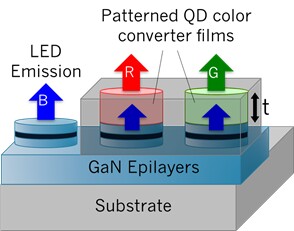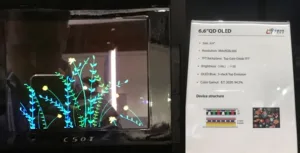When I attend SID Display Week, I spend my time immersed in the technical sessions or scouring the show floor looking for new public displays of QD-enabled technology. One blog just isn’t enough to cover it all, so here is the first half of a two-part series highlighting the trends as seen through my QD-colored lens.

#1 QLED and OLED – the lines are blurring
While the battle between QLED and OLED rages on in front of the public, the two technologies may actually merge together. The next few rollouts of top-tier displays could contain a combination of OLED and QLED technology. Here are two ways this could manifest.
- 1a. Blue OLED backlight with R/G QD down converter (sometimes referred to as QD color filter). It seems most panel makers have given up on the idea of a blue LED backlight with QD color filter as the in-cell polarizer may be too difficult to implement in mass production. But blue OLED could perform the same task as the LCD which means no polarizer may be needed since each sub-pixel is independently addressable. This is a technology that has been talked about for some time now, and although the recent news of Samsung’s delay in QD-OLED may have put a damper on things, this approach was still a commonly discussed topic at Display Week. Blue light leakage is still a challenge, which will likely mean we’ll have to retain color filters in order to capitalize on the color gamut that QDs can deliver, as well as reduce unintentional room light excitation of the QD layers (which will be at the front of the screen in this orientation).
CSOT showed the only QD/OLED demo on the show floor, and it was somewhat disappointing given all the hype about what this sort of display could look like. At 6.6 inches, the miniature display was tucked away in a dark corner due to the weak 50 nit output. They claimed >94% BT2020 gamut, but it was tough to be impressed with the still graphics that were shown. I’ll be honest, I was hoping for a larger QD color filter demo, but no one seemed to be up to the task.
QD color filter with OLED backlight. Photo credit: Palomaki Consulting
- 1b. Electroluminescent QD (QD-EL) By now, most of you probably know about QD-EL which could represent a paradigm shift in display technology, but did you know it could also meld with AMOLED? The structure of a QD-EL devices is not that different from OLED, except that the emitter is an inorganic particle rather than a chromophore in an organic host. It could make a lot of sense to combine the two technologies to get to the finish line sooner. For both OLED and QD-EL the challenge will be blue.
During technical sessions TCL highlighted their excellent progress on Cd-containing QD-EL devices which are achieving near commercial reliability for red and green (but still very poor for blue). Nanosys shared some promising results of their Cd-free QD-EL research which continues to progress nicely, but again the blue performance leaves a lot to be desired in terms of lifetime. A favorite slide in many of these presentations was the trend of increasing efficiency over time.
Make no mistake, the recent progress has been excellent (for both Cd and non-Cd systems), and EQE is arguably good enough across the board to claim commercial viability, but lifetime continues to be a challenge, and blue stands out as the most challenging of all. This remains the case with OLED as well, so it will be interesting to see what mix of R/G/B AMOLED/QLED becomes the first viable technology, and more importantly, what metrics are enhanced by these combinations (color gamut, brightness, viewing angle, lifetime).
- #2 QDs may be the keystone that helps microLED go to market. For the past few years, microLEDs have been a hot topic at Display Week, and this year was no exception. One thing I noticed this year is how many of the microLED companies were serious about making their first product with blue-only microLEDs aided by QDs as R/G color converters. This is likely to be the case because making R/G/B microLEDs continues to be an expensive challenge, and if you can eliminate the complexity by using only blue, the challenge is more surmountable. I noticed a few interesting ways of using QDs that could act as the enabling keystone that makes microLED viable.
 A simplified diagram of how QDs might be used on blue microLEDs to achieve full color. Source: Osinski & Palomaki, presented at June 2019 at SID Display Week (paper 4-5)
A simplified diagram of how QDs might be used on blue microLEDs to achieve full color. Source: Osinski & Palomaki, presented at June 2019 at SID Display Week (paper 4-5)
VueReal explained how they are using QDs to address the microLED yield challenge. They add one redundant blue sub-pixel and during inspection. If there is a bad sub-pixel, they use adaptive patterning to add QDs only to the good sub-pixels. The result is 3x redundancy with only 25% extra devices, making >99.999% yield within reach at a reasonable cost. (Ah – I wondered how they could make that claim in the Business Conference! – Man. Ed.)
Plessey had previously announced their partnership with Nanoco (who were noticeably absent from the conference except for the logo in the Plessey booth). Plessey uses QDs to generate their red and green sub-pixels for microdisplays, although at their booth they only showed monochrome displays.
Saphlux, A newcomer to the microLED game, Saphlux impressed me with a new strategy to achieving color conversion with QDs in a short path length. Instead of layering the QDs on top of microLEDs, their approach is to etch a porous structure into the GaN itself which acts as a sponge-like reservoir for the QD layer while inducing scattering which increases the effective path length and therefore color conversion. This approach was studied almost 10 years ago in a collaboration between Yale, Brown, and QD Vision for applications in solid state lighting (funded by DoE) but never found its way into a commercial product. Perhaps microLEDs will be the application where this technology can find a home?
So, there was lots of exciting QD-related technology in development at SID this year. Stay tuned for blog #2 which will cover two more trends in QDs for 2019! (PP)
Peter Palomaki is the owner and chief scientist at Palomaki Consulting, a firm specializing in helping companies solve big problems at the nanoscale. His uses his expertise in quantum dots and materials chemistry to solve challenging problems with clients large and small.

